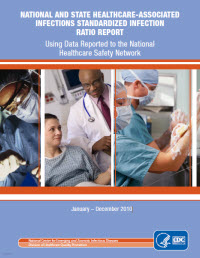National and State Healthcare-associated Infections Standardized Infection Ratio Report
Using Data Reported to the National Healthcare Safety Network
January – December 2010
Background
The National Healthcare Safety Network (NHSN) is a public health surveillance system that the Centers for Disease Control and Prevention’s (CDC) Division of Healthcare Quality Promotion (DHQP) maintains and supports as a mainstay of its Healthcare-associated infection (HAI) prevention program. NHSN is used by healthcare facilities in all 50 states, Washington, D.C., and Puerto Rico. Participation in NHSN is a state-mandated requirement for healthcare facilities in an increasing number of states. As of December 2011, 22 states and Washington, D.C., require, or have plans to require, use of NHSN for HAI reporting mandates. Central Line-associated bloodstream infections (CLABSIs) and Surgical Site Infections (SSIs) are the HAIs most frequently mandated by states that use NHSN as their operational system for mandatory reporting. As of January 2011, hospitals participating in the Centers for Medicare and Medicaid Services’ (CMS) Hospital Inpatient Quality Reporting Program are using NHSN to report CLABSIs among adult, pediatric, and neonatal intensive care unit patients. The CLABSI data reported via NHSN to CMS will be used to qualify hospitals for their annual payment update and for public reporting (starting January 2012) at the Department of Health and Human Services Hospital Compare web site. Similar reporting on SSIs to qualify hospitals began in January 2012. These mandates, coupled with the use of NHSN to comply with requirements by CMS, has led to a roughly 50% increase in the number of facilities reporting to NHSN between 2009 and the end of 2010.
Since NHSN’s inception in 2005, DHQP has used HAI data from the system for national-level analysis and reporting.1 Past reporting includes summary data that define the benchmarks used for interfacility comparisons such as location specific device-associated infection rates,1 risk adjustment models for SSIs,2 or summarized antimicrobial resistance data for each HAI type reported.3 This current report provides a summary of the characteristics of facilities reporting by state, and the key metrics of the HAI experience for the United States for 2010. It expands on previous reports in several ways.4 At the national level, reports on SSIs have been expanded to summarize select procedure-specific experience, and data on catheter-associated urinary tract infections (CAUTIs) has been added for the first time. In addition, for CLABSIs and CAUTIs, the standardized infection ratios (SIRs) are summarized for all patient care areas, and by major groupings of patient care areas (e.g., critical care areas, ward areas, neonatal intensive care units). State-specific summary statistics are again presented. Although these data are limited to CLABSI in this report, summary statistics are presented for all states, Washington, D.C., and Puerto Rico regardless of reporting mandates. As additional facilities begin reporting data on other HAI types in a more comprehensive manner that are reflective of state-specific progress, additional state-specific summary statistics will be included in future reports.
Changes in the 2009 SIR compared to the 2010 SIR are presented for CLABSI and SSI (20095 is the baseline year for CAUTI, so serial annual SIRs will be calculated next year), and for CLABSI it is also presented for each state. The goals of this report are to summarize available HAI data on CLABSI, SSI, and CAUTI data at the national level for 2010 and to gain additional perspective on the progress of HAI prevention nationally by comparison to the 2009 experience. This progress provides insights toward goals set forth in the Department of Health and Human Services (HHS) Action Plan to Prevent HAIs, and as states move forward with implementation of state HAI programs. The current report is limited to facilities reporting data from January 2010 through December 2010. However, during 2011, many states continued to make progress in extending NHSN surveillance activities to additional healthcare facilities.
The HAI data presented in this report are summarized using the SIR, a summary statistic used to measure relative difference in HAI occurrence during a reporting period compared to a common referent period (e.g., standard population). In HAI data analysis, the SIR compares the actual number of HAIs with the predicted number based on the baseline U.S. experience (e.g., standard population), adjusting for several risk factors that have been found to be most associated with differences in infection rates. The aggregate SIRs presented in this report are quantitative indicators of the current status of HAI prevention in acute care hospitals from across the United States for three major HAIs and of national progress toward their prevention. However, the SIRs are not intended to serve as comprehensive and conclusive HAI measures for all uses and users of HAI data. More specific data at the state and healthcare facility levels are needed to target specific HAI problems and monitor impact of prevention programs. Publication of this report is one step among many in providing data needed for analysis and action at all levels, with the intent of spurring additional progress toward HAI elimination throughout the United States.
Get email updates
To receive email updates about this page, enter your email address:
Contact Us:
- Centers for Disease Control and Prevention
1600 Clifton Rd
Atlanta, GA 30333 - 800-CDC-INFO
(800-232-4636)
TTY: (888) 232-6348 - New Hours of Operation
8am-8pm ET/Monday-Friday
Closed Holidays - cdcinfo@cdc.gov



